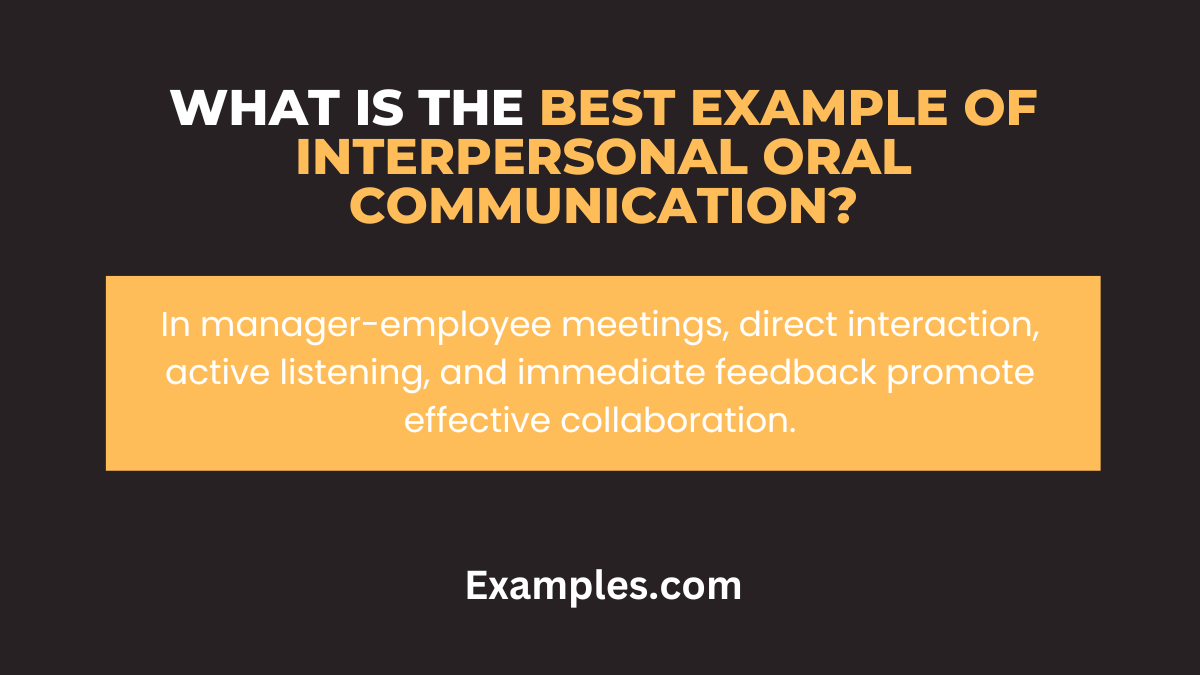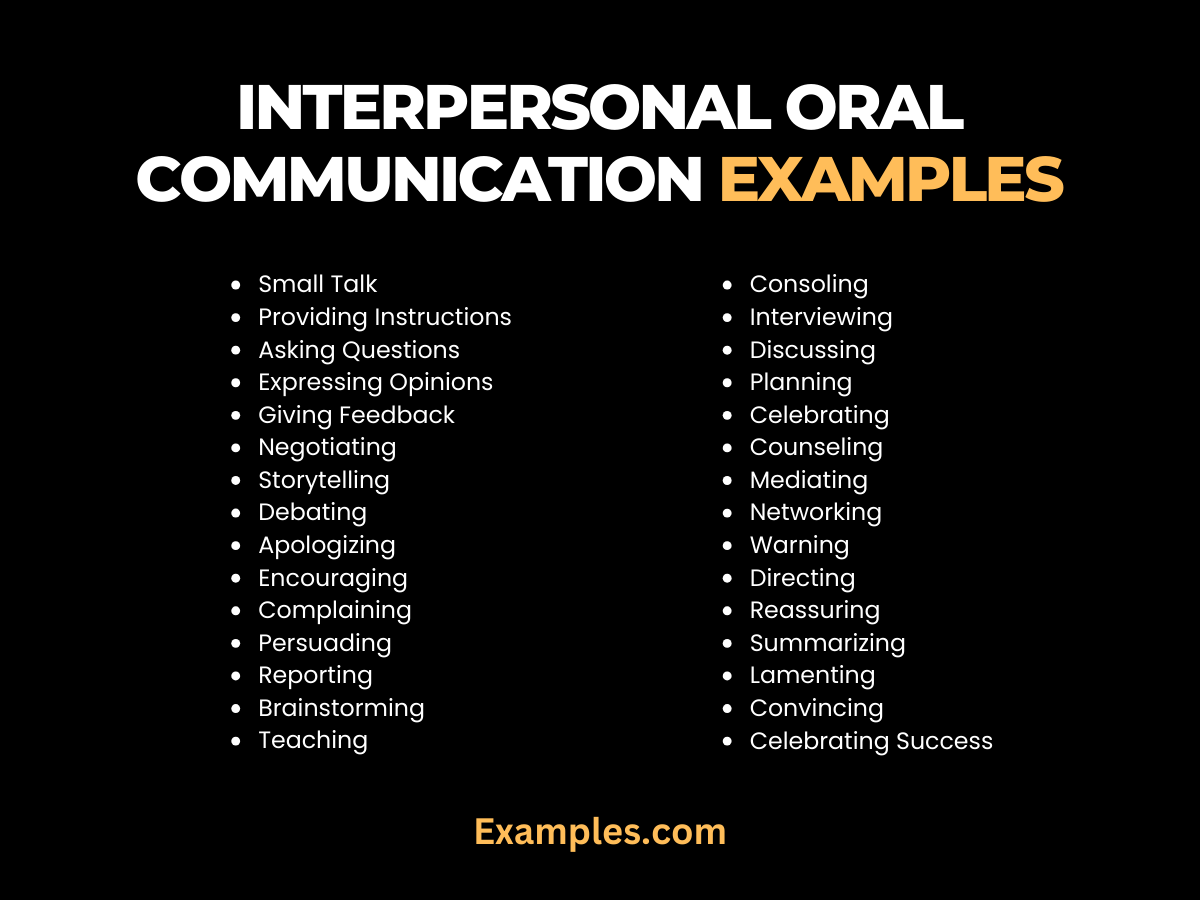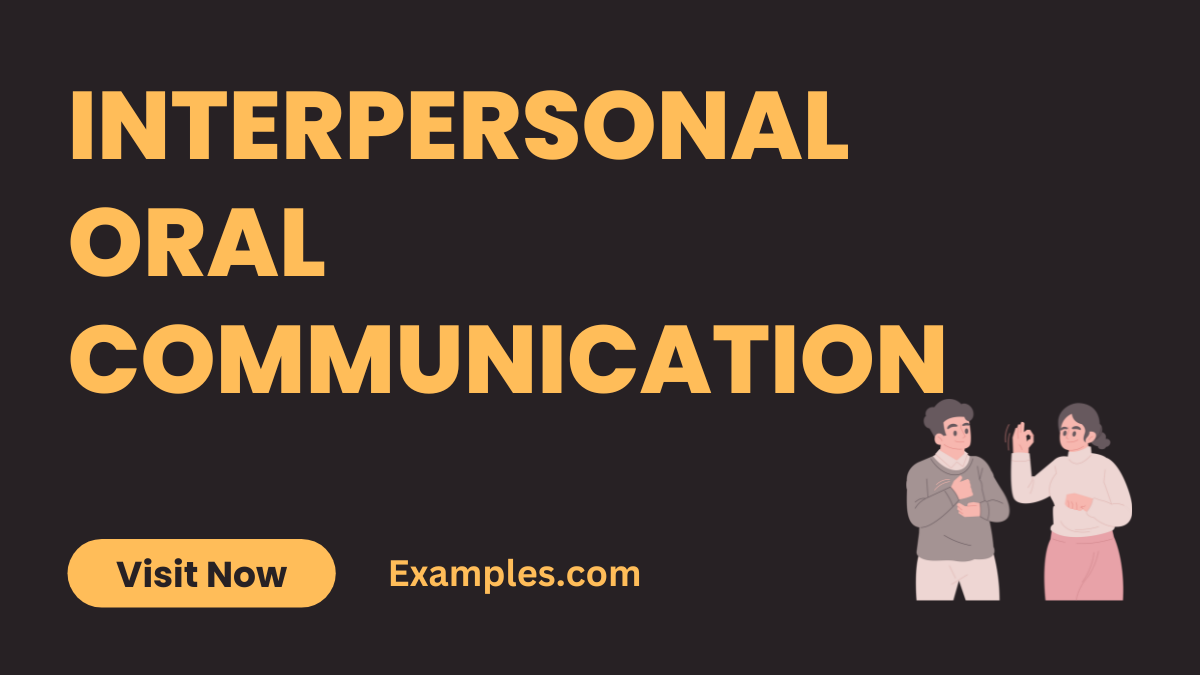29+ Interpersonal Oral Communication Examples
Interpersonal Oral Communication is an art that involves more than just speaking; it’s about connecting and understanding. This guide offers a deep dive into effective communication techniques, providing real-life communication examples and practical tips. Whether it’s mastering active listening in Oral Communication or ensuring clarity and confidence, each section is tailored to enhance your conversational skills. Perfect for professionals and individuals alike, these insights will transform your everyday interactions into impactful exchanges.
What is Interpersonal Oral Communication?

Interpersonal Oral Communication involves direct, face-to-face conversation between two or more individuals. It is not just about what is said, but how it is said, encompassing elements like tone, clarity, and body language. This form of communication is essential in building and maintaining personal and professional relationships, allowing for immediate feedback and deeper understanding.
What is the Best Example of Interpersonal Oral Communication?

A classic example of Interpersonal Oral Communication is a one-on-one meeting between a manager and an employee. This setting allows for direct, personal interaction where both parties engage in active listening and provide immediate feedback. The manager’s ability to speak clearly and confidently, combined with attentive listening, fosters a constructive and collaborative environment. This scenario demonstrates the power of effective oral communication in achieving mutual understanding and advancing shared goals.
30 Examples of Interpersonal Oral Communication

Interpersonal oral communication is a dynamic process that involves the exchange of verbal messages between individuals in various contexts. It’s essential for effective collaboration, relationship building, and understanding in both personal and professional settings. Incorporating active listening in oral communication and understanding in oral communication enhances the quality and effectiveness of these interactions. Here are 30 examples, each with a brief explanation and an example sentence.
- Small Talk: Casual conversation about non-controversial topics.
Example: “How was your weekend?” - Providing Instructions: Giving clear and concise directions.
Example: “Please organize these files by date.” - Asking Questions: Inquiring for information or clarification.
Example: “Can you explain how this process works?” - Expressing Opinions: Sharing personal views respectfully.
Example: “I believe we should prioritize this project.” - Giving Feedback: Offering constructive criticism or praise.
Example: “Your presentation was very informative and engaging.” - Negotiating: Discussing to reach an agreement.
Example: “Let’s find a middle ground that benefits both parties.” - Storytelling: Relaying events or experiences in an engaging manner.
Example: “Let me tell you about my trip to Spain.” - Debating: Engaging in argumentative discourse.
Example: “I disagree with that perspective, and here’s why…” - Apologizing: Expressing regret for a mistake.
Example: “I’m sorry for any misunderstanding caused.” - Encouraging: Offering support and motivation.
Example: “You’re doing great, keep it up!” - Complaining: Expressing dissatisfaction or annoyance.
Example: “I’m not happy with how this was handled.” - Persuading: Convincing others to adopt a certain viewpoint.
Example: “I urge you to consider this alternative.” - Reporting: Relaying information or updates.
Example: “The project is progressing as scheduled.” - Brainstorming: Generating ideas in a group.
Example: “What are your thoughts on solving this issue?” - Teaching: Imparting knowledge or skills.
Example: “This is how you operate the new software.” - Consoling: Offering comfort in times of distress.
Example: “I’m here for you during this tough time.” - Interviewing: Asking structured questions in a formal setting.
Example: “Can you describe a challenge you overcame?” - Discussing: Exchanging ideas on a particular topic.
Example: “What are your views on the current market trends?” - Planning: Organizing and strategizing future actions.
Example: “Let’s plan the steps for our next campaign.” - Celebrating: Expressing joy or congratulations.
Example: “Congratulations on your achievement!” - Counseling: Providing guidance or advice.
Example: “Let’s explore different options for your career.” - Mediating: Helping to resolve conflicts.
Example: “Let’s find a solution that works for everyone.” - Networking: Building professional relationships.
Example: “I’d love to learn more about your work.” - Warning: Advising of potential risks or dangers.
Example: “Be cautious when handling these chemicals.” - Directing: Leading or guiding others.
Example: “Please focus on completing the report by Friday.” - Reassuring: Offering assurance and confidence.
Example: “Everything will work out fine.” - Summarizing: Condensing information into a brief overview.
Example: “To summarize, we’ve covered the key project phases.” - Lamenting: Expressing sorrow or regret.
Example: “It’s unfortunate that the event was cancelled.” - Convincing: Swaying someone to your point of view.
Example: “I am confident that this is the right decision.” - Celebrating Success: Acknowledging and applauding achievements.
Example: “Your hard work has really paid off!”
What are the Types of Interpersonal Oral Communication?
| Type | Description |
|---|---|
| Informal Conversations | Casual, unstructured exchanges often occurring spontaneously. |
| Formal Presentations | Structured, prepared communication, typically in professional settings. |
| Group Discussions | Collaborative communication involving multiple participants exchanging ideas. |
| Meetings | Organized gatherings, usually with a specific agenda or goal. |
| Negotiations | Discussions aimed at reaching an agreement or resolving differences. |
| Interviews | Structured dialogues, often for information gathering or assessment. |
| Counseling Sessions | Conversations focused on advice or guidance. |
| Persuasive Speeches | Communication intended to influence or convince the audience. |
What are the Skills of Interpersonal Oral Communication?
- Active listening in Oral Communication: Paying full attention to the speaker, showing interest, and providing feedback.
- Clarity and Conciseness: Being clear and to the point, avoiding unnecessary jargon.
- Empathy and Understanding: Showing understanding and relating to the feelings of others.
- Non-Verbal Cues: Utilizing body language and facial expressions effectively.
- Feedback in Oral Communication: Giving and receiving constructive feedback.
- Adaptability: Adjusting communication style to suit the audience and context.
- Conflict Resolution: Effectively managing and resolving disagreements.
- Public speaking in Oral Communication: Speaking confidently and clearly in front of groups.
What is the Importance of Interpersonal Oral Communication in Workplace?
- Fosters Collaboration: Enhances teamwork and cooperation among colleagues.
- Improves Problem-Solving: Effective communication leads to better identification and resolution of issues.
- Enhances Leadership: Essential for leaders to guide and motivate their teams.
- Builds Relationships: Strengthens professional relationships through trust and understanding.
- Facilitates Change Management: Key in guiding teams through organizational changes.
- Improves Employee Engagement: Encourages participation and a sense of belonging.
- Enhances Decision Making: Effective communication leads to well-informed decisions.
- Boosts Productivity: Clear and efficient communication increases overall workplace efficiency.
How to Improve Interpersonal Oral Communication?
- Practice Active Listening: Focus on understanding the speaker without interrupting.
- Be Aware of Your Body Language: Ensure your non-verbal cues match your words.
- Speak Clearly and Confidently: Articulate your thoughts in a confident manner.
- Seek Feedback: Regularly ask for feedback on your communication style.
- Engage in Public Speaking: Develop your speaking skills through practice.
- Tailor Your Message: Adjust your communication style according to the audience.
- Emphasize Clarity and Conciseness: Be clear and concise in your communication.
- Develop Emotional Intelligence: Understand and manage your emotions effectively.
The mastery of interpersonal oral communication is not only transformative for personal relationships but is a cornerstone in professional settings as well. These skills are crucial in influencing interactions, building networks, and fostering career growth. For further exploration and enhancement of these skills, consider visiting VirtualSpeech’s insightful article, “Key Interpersonal Communication Skills you need to Improve,” at virtualspeech.com. Additionally, the Professional Leadership Institute offers an in-depth guide titled “Interpersonal Communication: Types, Examples, and How To Improve!” available at professionalleadershipinstitute.com. This resource is particularly beneficial for individuals aiming to enhance their interpersonal skills across various roles, including students, job candidates, and employees, covering critical areas such as assertiveness, teamwork, and public speaking.



